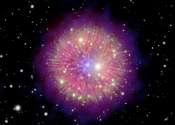Young and getting cooler -- the early life of a neutron star
(PhysOrg.com) -- Observations of how the youngest-known neutron star has cooled over the past decade are giving astronomers new insights into the interior of these super-dense dead stars. Dr Wynn Ho will present the findings ...









